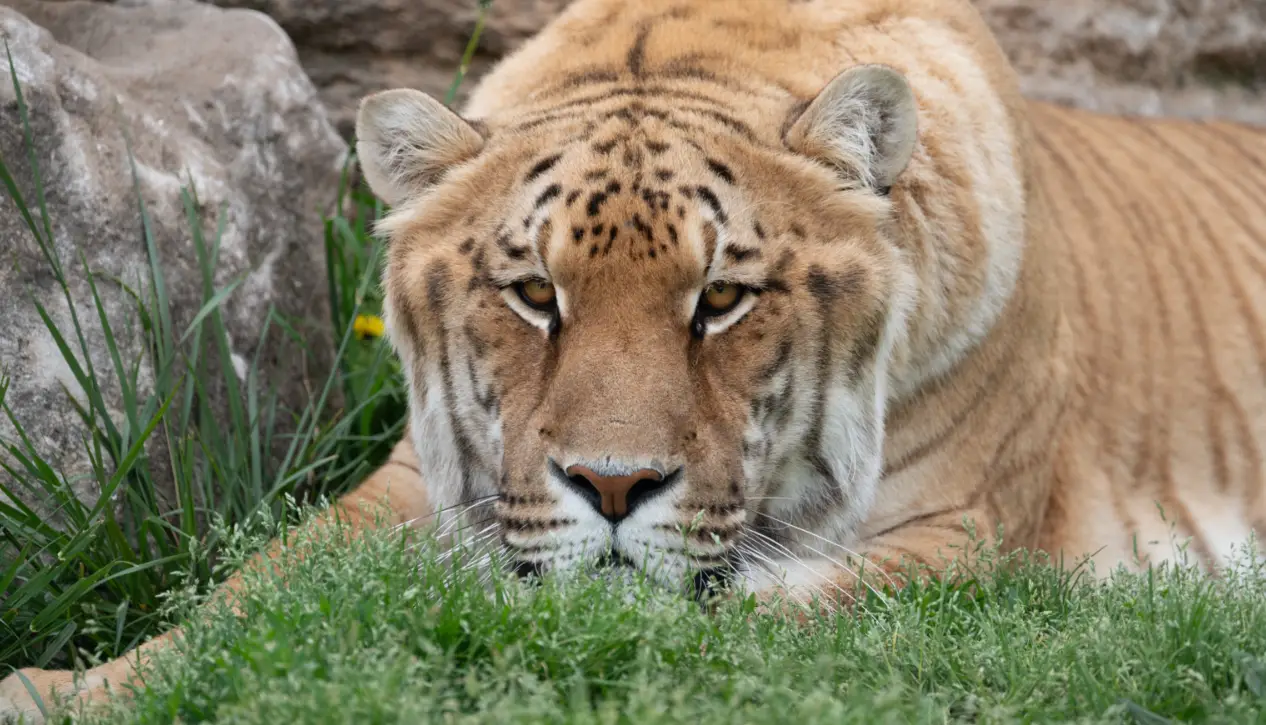What comes to mind when you think of the largest cat in the world? Lions and https://todaystories.net/tiger/s might be your first guesses, but the real answer lies in a hybrid species: the liger.
A crossbreed between a male lion and a female tiger, the liger holds the title as the largest feline in existence, sparking controversy for its very existence. Although impressive in size, ligers are artificially bred and raise numerous ethical and biological concerns. So, why do ligers exist, and should they?
What Is a Liger?
A liger is a hybrid big cat, created by crossing a male lion with a female tiger. This combination results in an animal that inherits traits from both parents, often growing larger than either species.
Unlike many hybrids in nature, ligers do not occur in the wild and are the result of intentional human breeding, typically for entertainment or profit.

The largest known liger, Hercules, resides in the Myrtle Beach Wildlife Refuge in South Carolina. Measuring 3.33 meters (11 feet) in length and weighing 418 kilograms (836 pounds), Hercules is a colossal example of this controversial hybrid.
The Origins of the Liger
The first recorded liger was bred in the 18th century by Étienne Geoffroy Saint-Hilaire, a French naturalist. At the time, these hybrids were created to amuse the royalty rather than for any scientific or conservation purpose.
It wasn’t until the 20th century that the term “liger” became widely recognized, as zoos and wildlife parks saw the liger’s massive size as a commercial attraction.
Understanding Hybrid Names: Ligers, Tigons, and More

The names of big cat hybrids are based on the species and gender of the parents. For instance:
- A liger is the offspring of a male lion and a female tiger.
- A tigon is the result of a male tiger mating with a female lion.
- A li-liger or ti-liger is a further hybrid, the offspring of a liger or tigon bred with another lion or tiger.
These hybrids display a mix of characteristics from their parent species, both in appearance and behavior, making them a curious, albeit controversial, creation.
The Gigantism of Ligers
Ligers are known for their extraordinary size, often exceeding the size of both lions and tigers. This gigantism occurs because female lions carry a gene that limits growth, while male tigers possess a gene that encourages it. In ligers, these genes do not balance out, resulting in an animal that grows rapidly without the natural checks of its parent species.
A liger cub just three months old can already surpass the size of a fully grown tiger cub of the same age.
Physical Characteristics of Ligers
Physically, ligers are a blend of both parent species. They typically have golden fur like lions but exhibit faint tiger stripes. Some male ligers may even develop a rudimentary mane, although it is not as prominent as a lion’s.
Standing nearly 3.6 meters (12 feet) tall when on their hind legs and weighing an average of 400 kilograms (882 pounds), these cats are built with larger bones and longer teeth than either lions or tigers.

The Ethical Dilemma: Should Ligers Exist?
From a natural standpoint, ligers shouldn’t exist. Lions and tigers do not share the same habitats, and even when their territories overlap in parts of Asia, they do not mate in the wild. The creation of ligers is solely the result of human intervention, often driven by financial motives rather than scientific or conservation goals.
Moreover, ligers require an immense amount of food—nearly three times what a normal tiger would need—making their care both expensive and unsustainable for most facilities. Reputable zoos typically avoid breeding ligers, recognizing that these animals offer no conservation value and come with a host of ethical concerns.
The Health Issues Plaguing Ligers
Despite their awe-inspiring size, ligers suffer from numerous health problems. Their rapid growth can cause complications during birth, often resulting in the need for cesarean sections. Even if ligers survive birth, they are prone to a variety of issues, including:
- Growth abnormalities
- Organ dysfunction
- Cardiovascular problems
- Weakened immune systems

Many ligers have significantly shorter lifespans, with many not surviving past seven years, compared to the 10-15 year lifespan of lions and tigers in captivity. While some ligers have been reported to live into their twenties, this is an exception rather than the norm.
Infertility and Reproduction Complications
Male ligers are almost always infertile due to their low testosterone levels and abnormal sperm production. Female ligers, however, are sometimes fertile and can mate with lions or tigers, resulting in further hybrids like the li-liger or ti-liger.
However, these offspring often inherit the same health complications as their parents, and many do not survive long after birth.
Behavioral Challenges of Ligers
In addition to physical issues, ligers face behavioral difficulties. They inherit characteristics from both parent species, which can lead to confusion and social problems.
For instance, ligers often exhibit the pride-living tendencies of lions but also enjoy swimming, like tigers. Their vocalizations are a mix too, as they can roar like a lion but also make a “chuffing” sound, unique to tigers.
These mismatched behaviors often leave ligers feeling out of place, unable to fully integrate with either lions or tigers, leading to potential psychological distress.
Tigons: The Other Hybrid Cat
Tigons, the offspring of a male tiger and a female lion, face similar issues but on a smaller scale. Unlike ligers, tigons inherit growth-limiting genes from both parents, keeping their size in check. As a result, they are significantly smaller than ligers, rarely weighing more than 150 kilograms (330 pounds).

Tigons also suffer from many of the same health issues as ligers, and like their hybrid counterparts, male tigons are infertile. While once popular, tigons have fallen out of favor due to breeding difficulties and their relatively smaller size compared to ligers.
Legal and Conservation Concerns
Globally, the breeding of hybrids like ligers and tigons is often illegal, as it is seen as a waste of valuable genetic resources. Protected species such as tigers are already endangered, and conservation efforts should focus on preserving their populations in the wild, not creating unnatural hybrids.
In some regions, hybrid animals are not afforded the same legal protections as their parent species. For instance, while tigers are protected under the U.S. Endangered Species Act, hybrids like ligers are not, leaving them vulnerable to exploitation and illegal trade.
The Sad Reality for Ligers and Tigons
At present, there are around 100 ligers and even fewer tigons alive globally. Despite their rare numbers, little research has been done on the long-term effects of hybridization on their health or behavior.

This lack of understanding further complicates their already precarious existence, and in many ways, hybrid animals like ligers are pitiful creatures born from human curiosity and greed rather than natural necessity.
Conclusion: Should We Be Breeding Ligers?
In the end, the creation of ligers and other hybrid animals raises difficult ethical questions. While they may appear majestic and awe-inspiring, the reality of their existence is fraught with health issues, behavioral challenges, and conservation concerns.
Breeding ligers purely for profit or spectacle is a disservice to both the animals themselves and the endangered species from which they originate. The world’s fascination with ligers may never fade, but their existence serves as a reminder of the dangers of playing with nature for entertainment.

FAQs
Are ligers the largest cats in the world? Yes, ligers are the largest known cat species, often growing larger than both lions and tigers.
Do ligers exist in the wild? No, ligers are artificially bred in captivity and do not occur naturally in the wild.
Why do ligers have so many health problems? Ligers suffer from health issues due to their unnatural size, which can lead to growth abnormalities, organ dysfunction, and other complications.
Are ligers protected by wildlife laws? Ligers are not protected by the same laws as their parent species, making them vulnerable to exploitation.
Why are ligers bred? Ligers are often bred for entertainment purposes or as a tourist attraction, despite having no conservation value.








